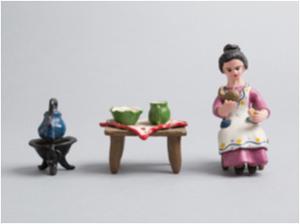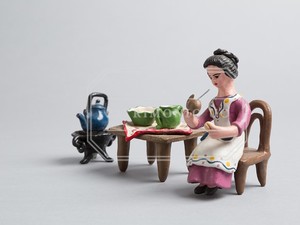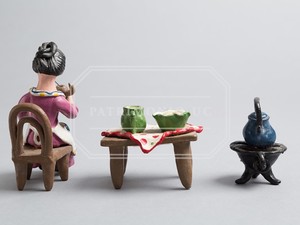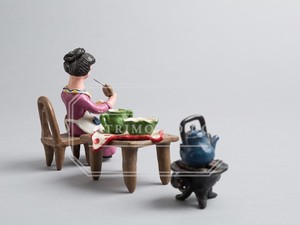Matera
| dc.coverage.spatial | Chile | |
| dc.date.accessioned | 2019-01-23T12:48:03Z | |
| dc.date.available | 2019-01-23T12:48:03Z | |
| dc.identifier | ChileUC (0101) | |
| dc.identifier.uri | https://archivospatrimoniales.uc.cl/handle/123456789/24790 | |
| dc.description.abstract | Traditional scene that has an anthropomorphic feminine figure as the main character, she has her hair tied on the top of her head, she's sitting on a chair with a mate in her right hand. On the table, we see a jar and a bread basket and next to it there is a brazier with a pot. This scene represents a mate usual consumption custom; a moment of meditation, rest and/or socialization in the Chilean culture. The technique used to make it is the direct hand modeling, cooking in a drum with fine firewood outdoors, gluing and painting. Maria Díaz Jorquera together with her sister Olga inherited this tradition from their mother, Luisa Jorquera López, who learned the trade from her mother on the last century, through the teachings of the Poor Clares nuns. This kind of craft started at the dawn of the 20th Century, and its origins date back to the activities developed by the nuns of Saint Clare, who had convents in Santiago and Linares. This Religious Order is well known for their ceramist tradition from the XII Century, whose main feature are the small figures and the perfume. | en |
| dc.description.abstract | Escena tradicional que tiene como figura principal una pieza antropomorfa femenina, que presenta el cabello recogido sobre su cabeza, sentada en una silla, sosteniendo un mate con la mano derecha, sobre la mesa se observa un jarrón y una panera y junto a ella un brasero con una tetera. Esta escena representa una práctica de consumo habitual de mate; momento que se asocia a la contemplación, descanso y/o socialización en la cultura chilena. La técnica de elaboración es modelado a mano directo, cocido en tambor con leña fina al aire libre, encolado y pintado. Maria Díaz Jorquera junto a su hermana Olga heredaron la tradición de su madre, Luisa Jorquera López, quien aprendió el oficio de su madre en el siglo pasado, a través de la enseñanza de las Monjas Claras. Esta artesanía comienza en los albores del siglo XX, y los origenes se remontan a las actividades desarrolladas por las monjas de Santa Clara, que tenian conventos en Santiago y Linares. Esta Orden Religiosa destaca entre sus actividades la tradición ceramista que se remonta al siglo XII, cuya principal característica son las pequeñas figuras y el perfume. | |
| dc.format.extent | Figura Femenina: Alto 7,5 cm Ancho 4 cm Largo 3,5 cm | |
| dc.relation.ispartof | Colección de Artesanía UC : Colección Piezas de Artesanía | |
| dc.relation.ispartofseries | Alfarería | |
| dc.subject.other | Artesanía | |
| dc.subject.other | Hecho a mano | |
| dc.subject.other | Zona central | |
| dc.subject.other | Mujer campesina | |
| dc.subject.other | Cerámica policromada | |
| dc.subject.other | Figura humana | |
| dc.title | Matera | |
| dc.type | Objeto | |
| dc.ubicacion | Biblioteca Sergio Larraín | |
| dc.rubro | Alfarería | |
| dc.material | Arcilla | |
| dc.funcion | Decorativo | |
| dc.conservacion.estado | Bueno: No registra deterioros a nivel de su estructura y materiales, y su manipulación se puede realizar sin ningún problema. | |
| dc.cultura | Mestizo | |
| dc.localidad | Talagante | |
| dc.region | Región Metropolitana | |
| dc.fuente.origen | Programa de Artesanía UC |















